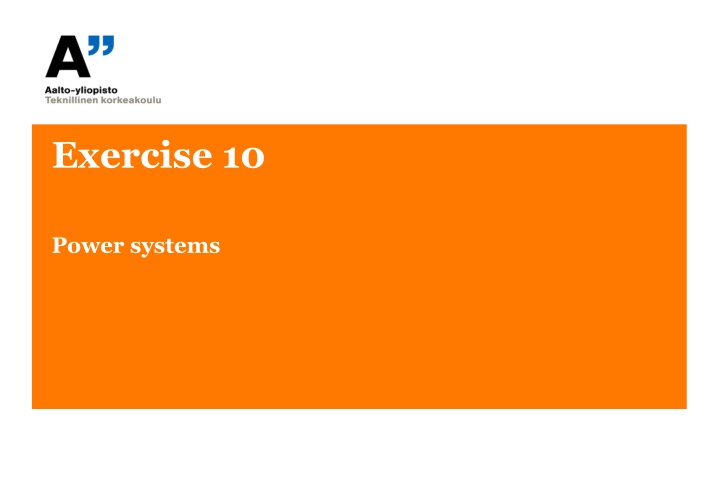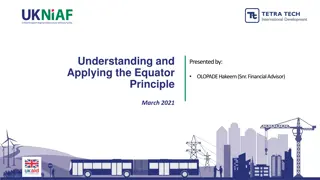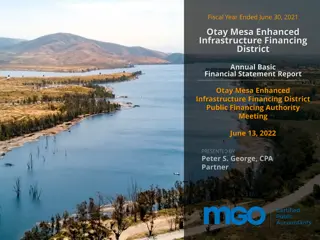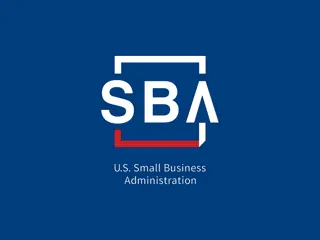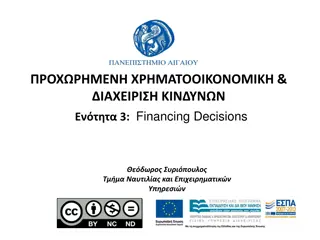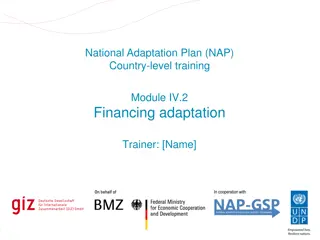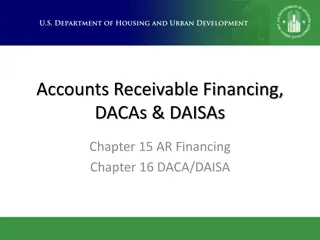Financial Concepts and Methods of Financing in Workplace
Financial documents such as receipts, invoices, and payslips in the context of small and home-based workplaces and businesses. Understand concepts like cost price, selling price, exchange rate, UIF contributions, income tax, and more.
Uploaded on Feb 25, 2025 | 0 Views
Download Presentation

Please find below an Image/Link to download the presentation.
The content on the website is provided AS IS for your information and personal use only. It may not be sold, licensed, or shared on other websites without obtaining consent from the author.If you encounter any issues during the download, it is possible that the publisher has removed the file from their server.
You are allowed to download the files provided on this website for personal or commercial use, subject to the condition that they are used lawfully. All files are the property of their respective owners.
The content on the website is provided AS IS for your information and personal use only. It may not be sold, licensed, or shared on other websites without obtaining consent from the author.
E N D
Presentation Transcript
Exercise 10 Power systems
Question 1 A three-phase power line consists of three parallel conductors in the same horizontal plane. The two outer conductors are each 1 m from the center conductor. If the conductor diameter is 6 mm, calculate the average inductance per phase of a 1 km length of the line. Assume the expression for the inductance per meter of length.
Question 1 A three-phase power line consists of three parallel conductors in the same horizontal plane. The two outer conductors are each 1 m from the center conductor. If the conductor diameter is 6 mm, calculate the average inductance per phase of a 1 km length of the line. Assume the expression for the inductance per meter of length.
Question 1 Inductance, when conductor diameter is 6 mm 3 3 = = = 1 1 2 2 d d m m eq d 6 mm 3 c = = = = mm 3 3 10 m r 2 2 1 H d 7 = + 2 10 ln L 4 m r 1km : 3 1 2 H 7 = + 2 10 ln 1000 m L 3 4 m 3 10 = . 1 26 mH
Question 2 In a three-core cable, the capacitance between the three cores short-circuited together and the sheath is 0.87 F/km, and that between two cores connected together to with the sheath and the third core is 0.84 F/km. Determine the MVA required to keep 16 km of this cable charged when the supply is 33 kV, three phase, 50 Hz.
Question 2 MVA for charging 16 km of cable with 33 kV supply 2) Three-core cable: 1) 1) Capacitance between the three cores short-circuited together and the sheath is 0.87 F/km: n 1 F F = = = = . 0 87 3 . 0 29 C C C C C1 C1 C1 CA 1 1 A A parallel km 3 km 2) Between two cores connected together with the sheath and the third core is 0.84 F/km: n F = = + . 0 84 2 C C C 2 1 B km C2 C2 C1 CB 1 1 F F ( ) ( . 0 ) = = = 84 . 0 29 . 0 275 C C C 2 1 B 2 2 km km
Question 2 MVA for charging 16 km of cable with 33 kV supply We can make a delta-star transformation for easier solution: U 2 = = = UI 3 sin 3 3 Q U U Y ( 1 Z = .) cap power 2 equilibriu m 1 U U 2 = = = = 3 sin 3 Q I U Y Q ( 1 Z 3 3 = .) cap = 3 Y Y
Question 2 MVA for charging 16 km of cable with 33 kV supply F F = = . 0 29 . 0 275 C C 1 2 Something to go after km km From the sheats/neutrals perspective: n Cap. per phase : F F ( . 0 ) = + = + = 3 29 3 . 0 275 . 1 115 C C C 1 2 km km F = = For a three-phase system the apparent power is: For a 16 - km cable : C . 1 115 16 km 17 84 . F km 2 ( ) 1 Z U 2 2 2 2 6 3 = = = = = 3 2 2 50 17 84 . 10 33 10 VA S YU CU fCU 3 = 1 . 6 MVA
Question 3 An AAC is composed of 37 strands, each having a diameter of 0.333 cm. Compute the dc resistance in ohms per kilometer at 75 C. Assume that the increase in resistance due to spiraling is 2%. Use resistivity for aluminum: 0.0283 mm^2/m at 20 C temperature dependence: 0.00403 / C
An AAC is composed of 37 strands, each having a diameter of 0.333 cm. Compute the dc resistance in ohms per kilometer at 75 C. Assume that the increase in resistance due to spiraling is 2%. Question 3 dc resistance AAC is an all-aluminum conductor 8 = . 2 83 = 0.00403 per C 10 m at 20 C Resistivity and Diameter of a strand is d = 0.333 cm = 0.00333 m ( . 0 ) 2 4 2 = = Total area of the conducting material 37 00333 . 3 222 10 A m 4 l = R 20 A 8 R . 2 83 10 m 20 l = = 1000 4 2 A . 3 222 10 m = 0878 . 0 km
An AAC is composed of 37 strands, each having a diameter of 0.333 cm. Compute the dc resistance in ohms per kilometer at 75 C. Assume that the increase in resistance due to spiraling is 2%. Question 3 dc resistance km R 20 l = 0878 . 0 Spiraling R effect : ' l R 20 20 l = = 0878 . 0 = . 1 02 . 1 02 0896 . 0 km km Zero at DC '20 R R 1 ( ) 75 = + 75 20 l l 1 ( ) = + = 0896 . 0 00403 . 0 75 20 . 0 109 km
Question 4 A three-phase 60-Hz line has flat horizontal spacing. The conductors have an outside diameter of 3.28 cm with 12 m between conductors. Determine the capacitive reactance to neutral in ohm-meters and the capacitive reactance of the line in ohms if its length is 200 km. Presume that the distance to ground is much larger than the distance between conductors.
Question 4 2 2 F 0 0 = = C 2 ha a A 2 m ln ln ln rA r h When the distance to ground (h) is much larger than the distance between the conductors, the total distances of 2h and A are nearly equal. That is to say: 2 2 2 F 0 0 0 = = C a A 2 a a m ( ) 1 ln ln ln ln ln r h r r
A three-phase 60-Hz line has flat horizontal spacing. The conductors have an outside diameter of 3.28 cm with 12 m between conductors. Determine the capacitive reactance to neutral in ohm-meters and the capacitive reactance of the line in ohms if its length is 200 km. Presume that the distance to ground is much larger than the distance between conductors. Question 4 = = = = = 3.28 12 200 0.0328 0.0164 d D l cm m km m r m D D 3 = = = 12 12 24 m 15 12 . m 3 D D D D eq ab bc ac The line-to-neutral capacitance per meter and capacitive reactance in ohm-meters: 9 2 F 10 F 9 10 F F 12 12 0 = = = = = . 8 138 10 C . 8 842 10 0 36 m m 15 12 . D m m eq 18 ln ln 0164 . 0 r D eq ln D r 1 C eq 7 8 = = = = . 4 77 10 ln . 3 256 10 m X C 109 r 2 60 2 36
A three-phase 60-Hz line has flat horizontal spacing. The conductors have an outside diameter of 3.28 cm with 12 m between conductors. Determine the capacitive reactance to neutral in ohm-meters and the capacitive reactance of the line in ohms if its length is 200 km. Presume that the distance to ground is much larger than the distance between conductors. Question 4 = = = = = 3.28 12 200 0.0328 0.0164 d D l cm m km m r m Line capacitance and reactance for the 200 km line: F 1000 m 12 = = . 8 138 10 200 km 1.63 C F m km 1 1 = = = 1627 XC C 6 2 60 . 1 63 10
